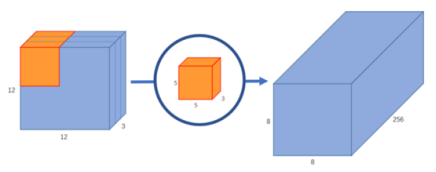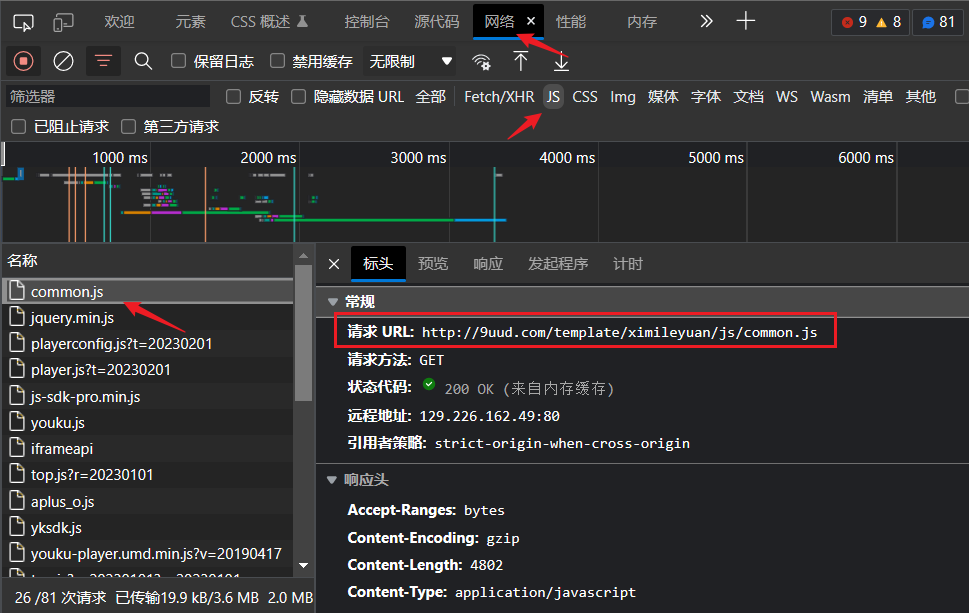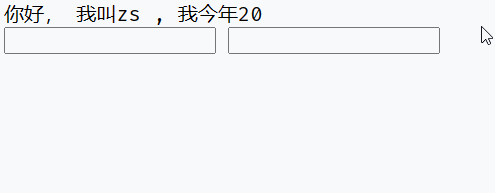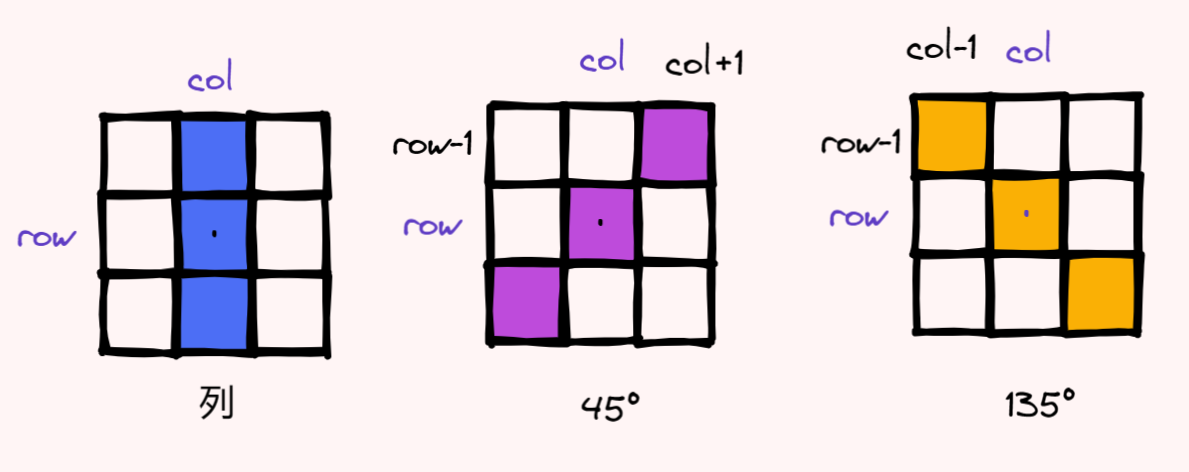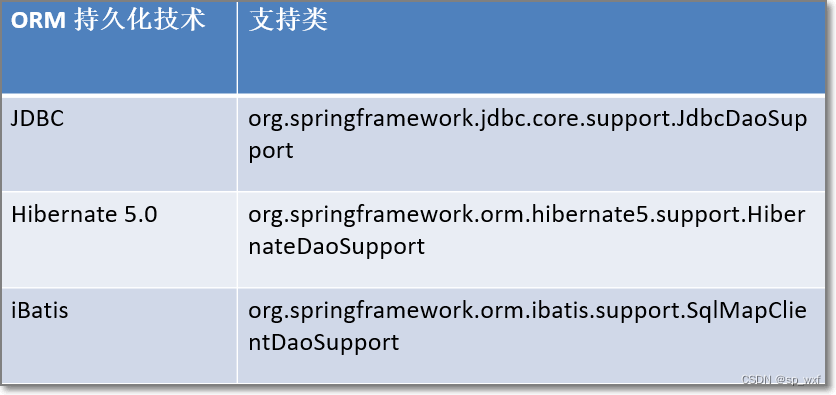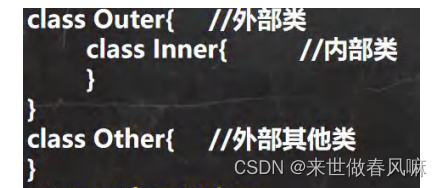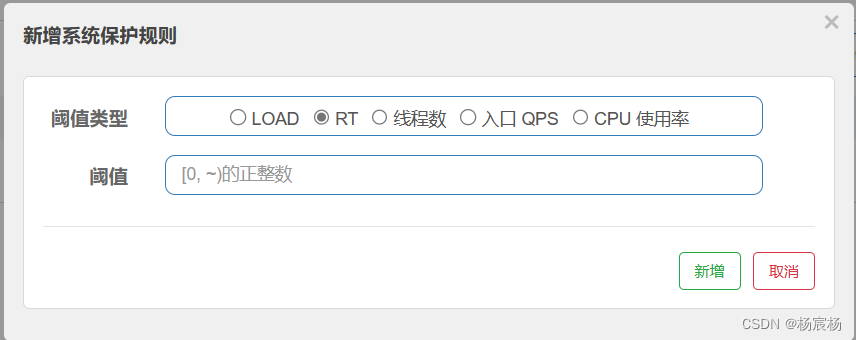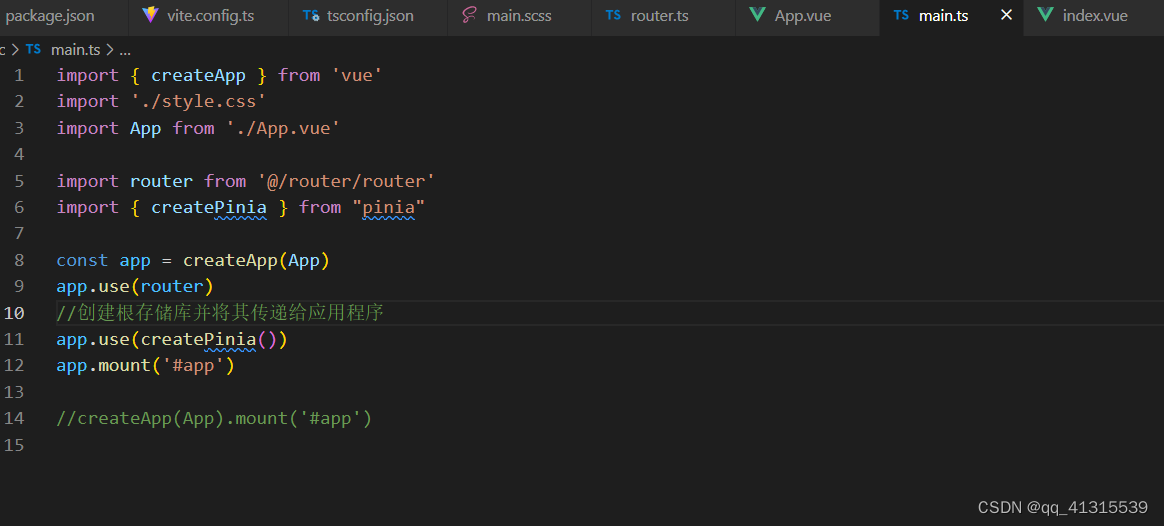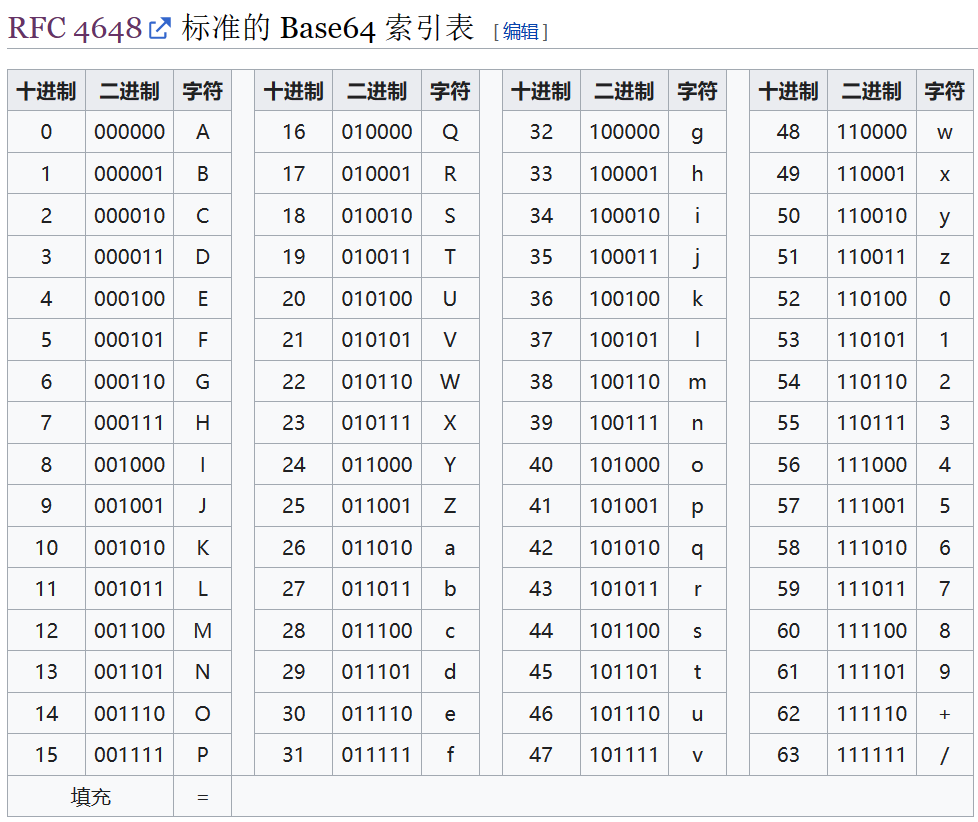为什么要分析DefaultAttributeMap和AttributeKey呢?我自己对Netty也是一个不断的学习过程,从前面几篇Netty分析的博客中,可以看出,Netty是比较博大精深的,很像java.util.concurrent.*包中的源码,如果只是看主体流程,就会觉得Netty不就是一个接收数据,并将数据封装到业务端代码,业务端处理完代码后,再将数据封装返回给客户端不? 主体代码固然不错,但这些细节代码也值得我们学习,正是因为这些细节处理得足够好,我觉得Netty的高性能,离不开这些细节代码的支持。因此今天要分析一下DefaultAttributeMap及AttributeKey的实现原理。
在分析Netty 服务端源码中遇到一个代码块,请看下图。
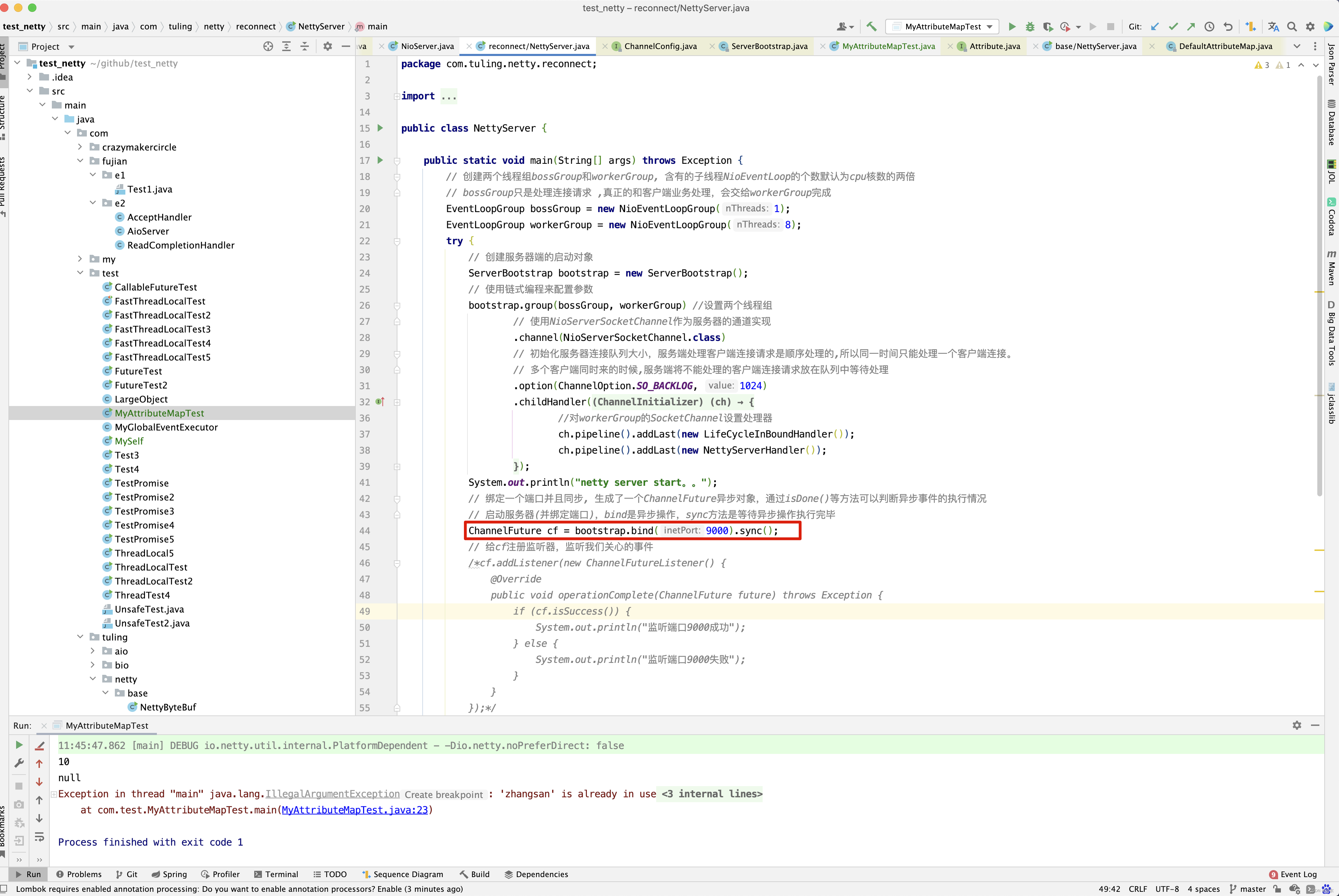
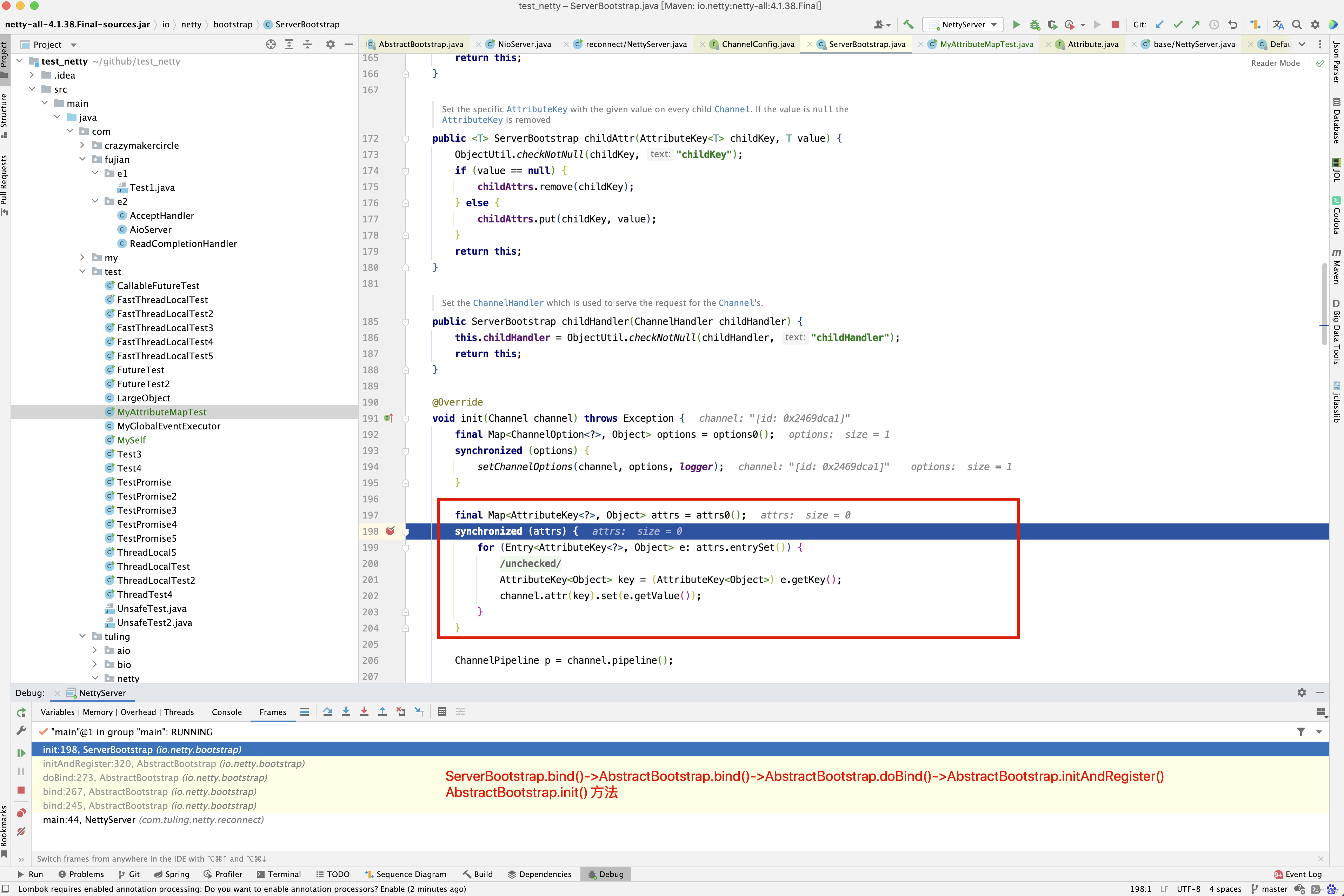
在ServerBootstrap的bind()方法调用过程中,调用了init()方法 。上图中的Channel就是NioServerSocketChannel,那NioServerSocketChannel和DefaultAttributeMap有什么关系呢?请看下图
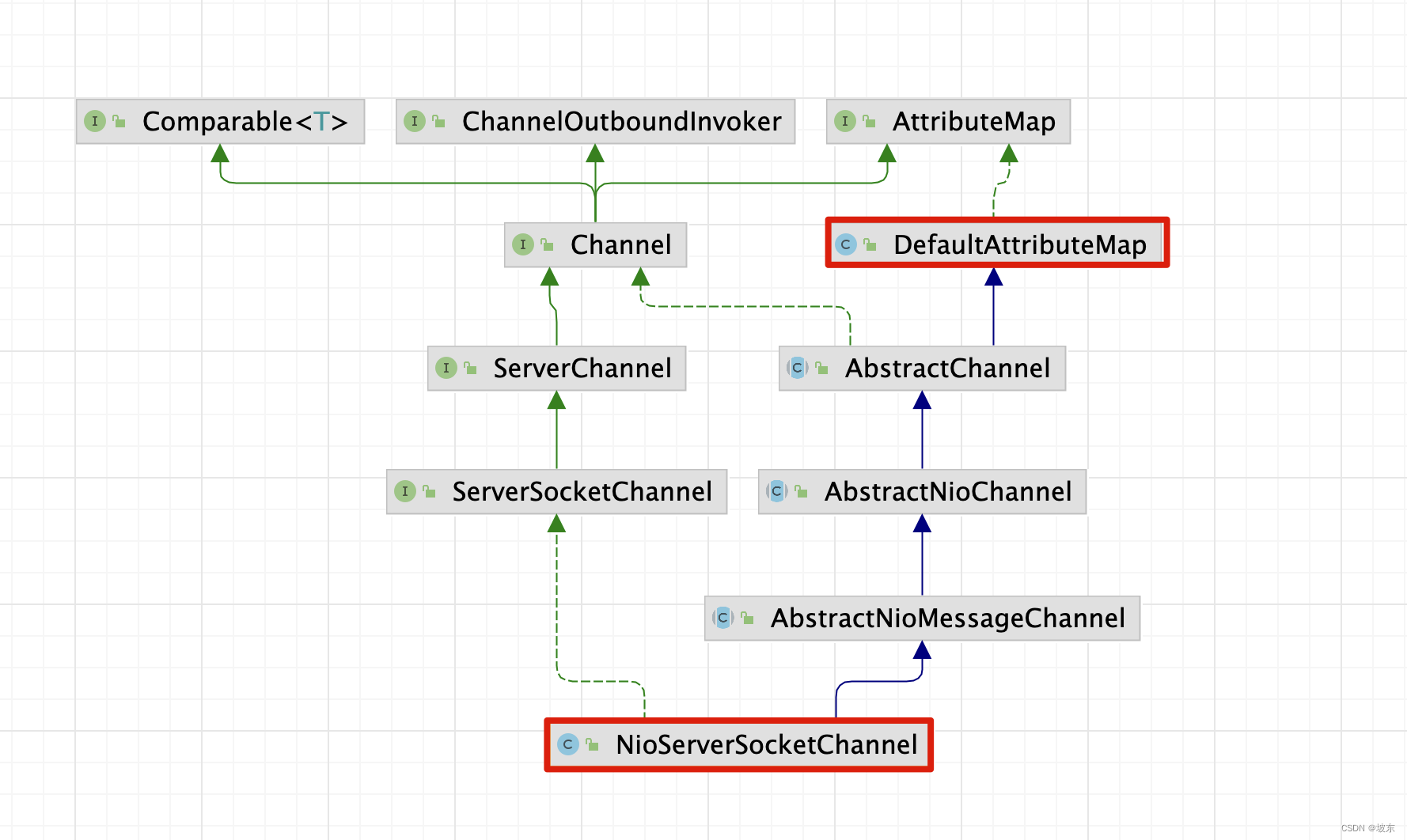
弄明白它们之间的关系,接下来进入DefaultAttributeMap和AttributeKey的原理分析 。
既然要分析源码,那肯定还是从例子学起。 请看下面例子。
public static void main(String[] args) {
AttributeKey<String> key = AttributeKey.newInstance("zhangsan");
DefaultAttributeMap defaultAttributeMap = new DefaultAttributeMap();
Attribute attr= defaultAttributeMap.attr(key);
attr.set(10);
System.out.println(attr.getAndRemove());
System.out.println(attr.get());
AttributeKey<String> key1 = AttributeKey.newInstance("zhangsan");
}
创建一个AttributeKey对象,并为其设置值为10 , 调用getAndRemove()方法获取值为10,再调用get()方法返回空, 显然,10在getAndRemove()方法中被移除再,再次实例化name为zhangsan的AttributeKey,抛出异常。

我们就围绕着上述例子来分析源码 。
AttributeKey
首先看AttributeKey的类结构
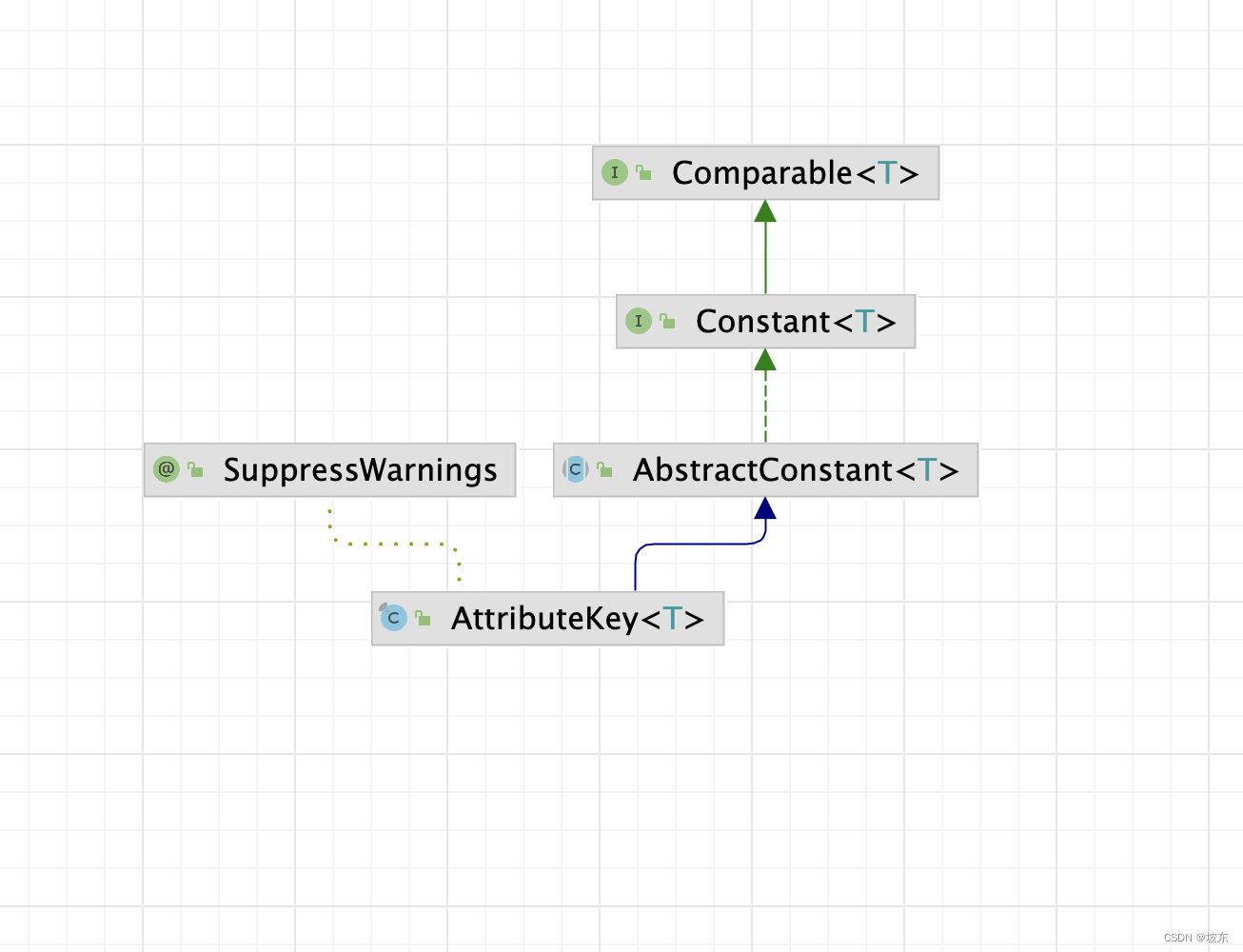
public final class AttributeKey<T> extends AbstractConstant<AttributeKey<T>> {
private static final ConstantPool<AttributeKey<Object>> pool = new ConstantPool<AttributeKey<Object>>() {
@Override
protected AttributeKey<Object> newConstant(int id, String name) {
return new AttributeKey<Object>(id, name);
}
};
public static <T> AttributeKey<T> valueOf(String name) {
return (AttributeKey<T>) pool.valueOf(name);
}
public static boolean exists(String name) {
return pool.exists(name);
}
public static <T> AttributeKey<T> newInstance(String name) {
return (AttributeKey<T>) pool.newInstance(name);
}
public static <T> AttributeKey<T> valueOf(Class<?> firstNameComponent, String secondNameComponent) {
return (AttributeKey<T>) pool.valueOf(firstNameComponent, secondNameComponent);
}
private AttributeKey(int id, String name) {
super(id, name);
}
}
当 newInstance( name) 方法时,实际上调用的是pool.newInstance(name)方法 ,进入pool的newInstance()方法 。
private final ConcurrentMap<String, T> constants = PlatformDependent.newConcurrentHashMap();
private final AtomicInteger nextId = new AtomicInteger(1);
public T newInstance(String name) {
checkNotNullAndNotEmpty(name);
return createOrThrow(name);
}
private T createOrThrow(String name) {
T constant = constants.get(name);
if (constant == null) {
final T tempConstant = newConstant(nextId(), name);
// 如果name已经存在于constants中,则不会执行插入操作
constant = constants.putIfAbsent(name, tempConstant);
if (constant == null) {
return tempConstant;
}
}
throw new IllegalArgumentException(String.format("'%s' is already in use", name));
}
public final int nextId() {
return nextId.getAndIncrement();
}
从上面代码中得知,最终调用的是AttributeKey中的newConstant()方法,创建了AttributeKey()对象,当然id为自增id , name 为我们传入的名字,在例子中两次调用AttributeKey.newInstance(“zhangsan”)方法, 第二次抛出IllegalArgumentException异常。

原因就在于createOrThrow()方法 , 如果constants中有name相同的key时, 则无法进行插入操作。引发后面的IllegalArgumentException异常。
接下来看DefaultAttributeMap的实现。
DefaultAttributeMap
public class DefaultAttributeMap implements AttributeMap {
// 以原子方式更新attributes变量的引用
private static final AtomicReferenceFieldUpdater<DefaultAttributeMap, AtomicReferenceArray> updater =
AtomicReferenceFieldUpdater.newUpdater(DefaultAttributeMap.class, AtomicReferenceArray.class, "attributes");
// 默认桶的大小4
private static final int BUCKET_SIZE = 4;
// 掩码为3
private static final int MASK = BUCKET_SIZE - 1;
// Initialize lazily to reduce memory consumption; updated by AtomicReferenceFieldUpdater above.
// 延迟初始化,节约内存
private volatile AtomicReferenceArray<DefaultAttribute<?>> attributes;
@Override
public <T> Attribute<T> attr(AttributeKey<T> key) {
if (key == null) {
throw new NullPointerException("key");
}
AtomicReferenceArray<DefaultAttribute<?>> attributes = this.attributes;
// 当attributes为空时则创建它,默认数组长度4
if (attributes == null) {
// Not using ConcurrentHashMap due to high memory consumption.
// 没有使用ConcurrentHashMap为了节约内存
attributes = new AtomicReferenceArray<DefaultAttribute<?>>(BUCKET_SIZE);
// 原子方式更新attributes,如果attributes为null则把新创建的对象赋值,原子方式更新解决了并发赋值问题
if (!updater.compareAndSet(this, null, attributes)) {
attributes = this.attributes;
}
}
// 计算key所在数组下标 ,相当于 key.id % 3
int i = index(key);
DefaultAttribute<?> head = attributes.get(i);
// 头部为空说明第一次添加,这个方法可能多个线程同时调用,因为判断head全部为null
if (head == null) {
// No head exists yet which means we may be able to add the attribute without synchronization and just
// use compare and set. At worst we need to fallback to synchronization and waste two allocations.
// 创建一个空对象为链表结构的起点
head = new DefaultAttribute();
// 创建一个attr对象,把head传进去
DefaultAttribute<T> attr = new DefaultAttribute<T>(head, key);
// 链表头head的next = attr
head.next = attr;
// attr的prev = head
attr.prev = head;
// 给数组i位置赋值,这里用compareAndSet原子更新方法解决并发问题,只有i位置为null能够设置成功,且只有一个线程能设置成功
if (attributes.compareAndSet(i, null, head)) {
// we were able to add it so return the attr right away
return attr;
} else {
//设置失败的,说明数组i位置已经被其它线程赋值
//所以要把head重新赋值,不能用上面new出来的head,需要拿到之前线程设置进去的head
head = attributes.get(i);
}
}
// 对head同步加锁
synchronized (head) {
//curr 赋值为head head为链表结构的第一个变量
DefaultAttribute<?> curr = head;
for (;;) {
// 依次获取next
DefaultAttribute<?> next = curr.next;
// next==null,说明curr为最后一个元素 ,
// 将新创建的节点插入到尾节点
if (next == null) {
// 创建一个新对象传入head和key
DefaultAttribute<T> attr = new DefaultAttribute<T>(head, key);
// curr后面指向attr
curr.next = attr;
// attr的前面指向curr
attr.prev = curr;
// 返回新对象
return attr;
}
// 如果next的key等于传入的key,并且没有被移除
// 则返回链表中的节点即可
if (next.key == key && !next.removed) {
// 这直接返回next
return (Attribute<T>) next;
}
// 否则把curr变量指向下一个元素
curr = next;
}
}
}
private static int index(AttributeKey<?> key) {
// 与掩码&运算,数值肯定<=mask 正好是数组下标
return key.id() & MASK;
}
首先要理清DefaultAttributeMap的结构,其实是一个数组长度为4的数组链表结构 。

上面代码分3种情况 。 我们用图来展示 。
-
第一种情况, key 对应的数组下标处没有头节点。创建头节点,并将创建next节点,再将头节点CAS操作插入到数组对应下标处。
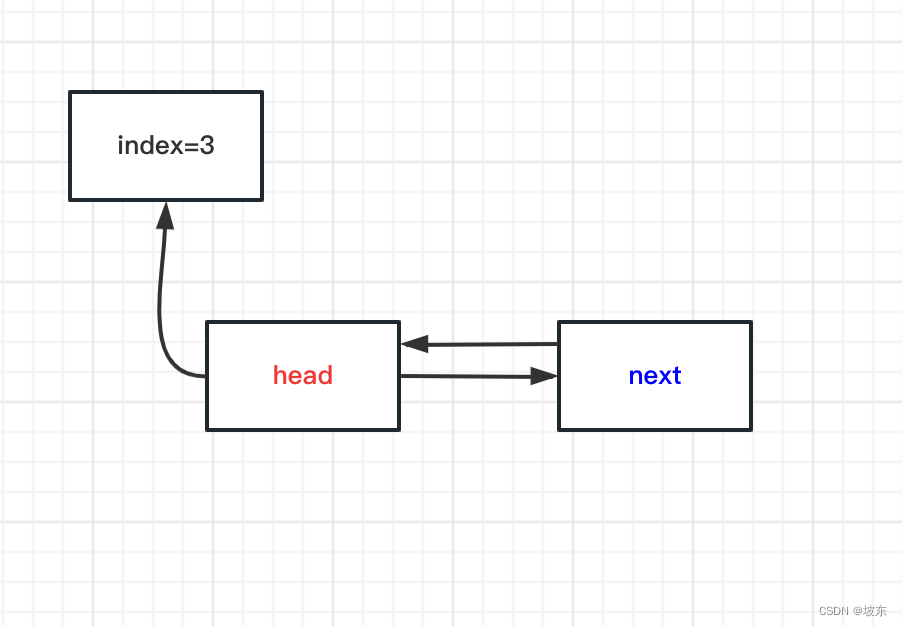
-
多线程并发将头节点插入到数组索引为3处,此时必然一个线程成功,一个线程失败,失败的线程继续将新创建的next节点插入到index为3的链表结尾 。

-
如果next1的key和传入的key相等,并且next1 并没有被移除掉,则返回next1即可。
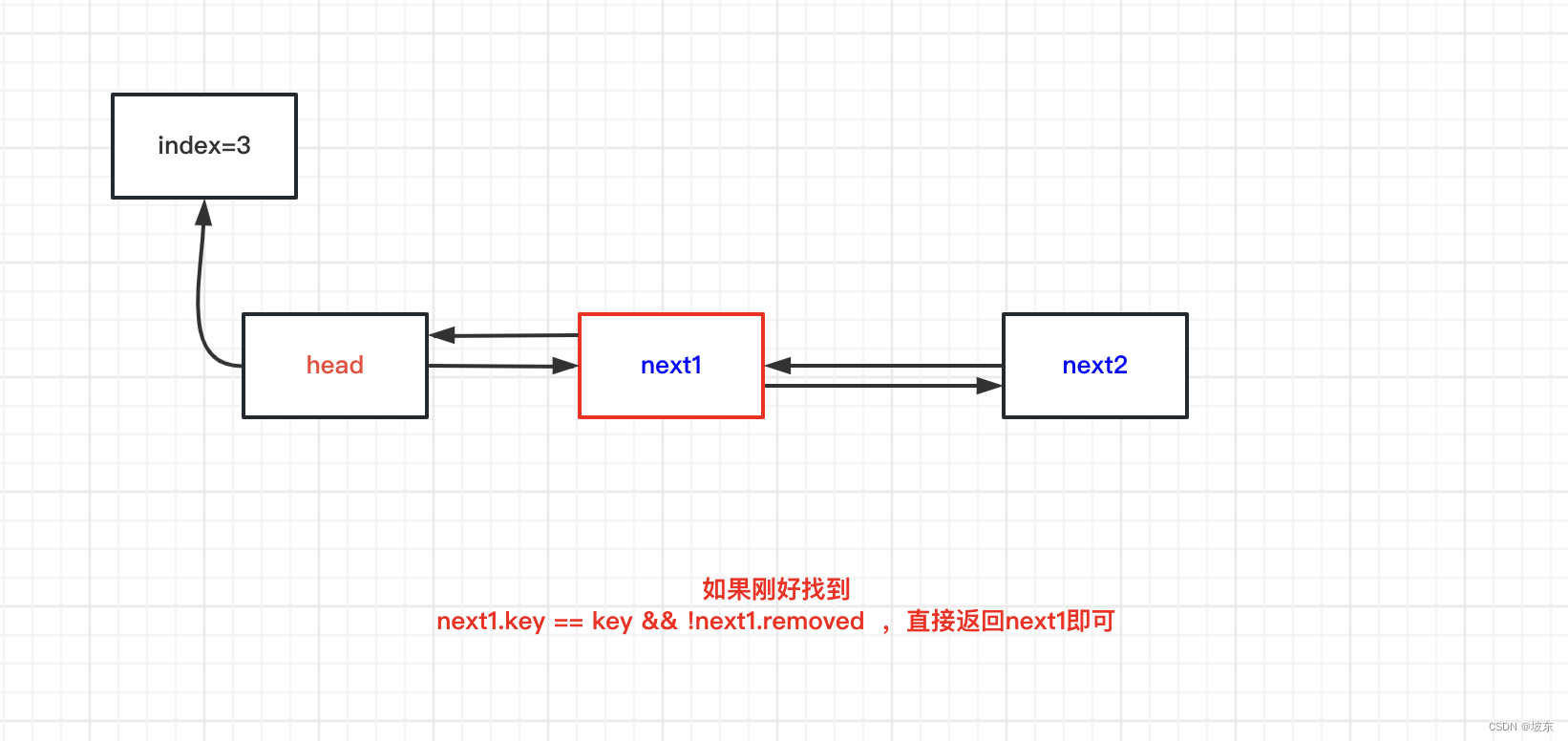
hasAttr()方法的实现原理和attr()方法的实现原理类似,这里不做过多分析 。
@Override
public <T> boolean hasAttr(AttributeKey<T> key) {
if (key == null) {
throw new NullPointerException("key");
}
// attributes为null直接返回false
AtomicReferenceArray<DefaultAttribute<?>> attributes = this.attributes;
if (attributes == null) {
// no attribute exists
return false;
}
// 计算数组下标
int i = index(key);
// 获取头 为空直接返回false
DefaultAttribute<?> head = attributes.get(i);
if (head == null) {
// No attribute exists which point to the bucket in which the head should be located
return false;
}
// We need to synchronize on the head.
// 对head同步加锁
synchronized (head) {
// Start with head.next as the head itself does not store an attribute.
// 从head的下一个开始,因为head不存储元素
DefaultAttribute<?> curr = head.next;
// 为null说明没有节点了
while (curr != null) {
// key一致并且没有被移除则返回true
if (curr.key == key && !curr.removed) {
return true;
}
// curr指向下一个
curr = curr.next;
}
return false;
}
}
从DefaultAttribute的结构得知,其实在之前的图表中,每个节点还有一条线没有画, 如果画上去太多了,不方便突出重点 。 这里补充上,实际DefaultAttribute节点之间的关系图如下 。
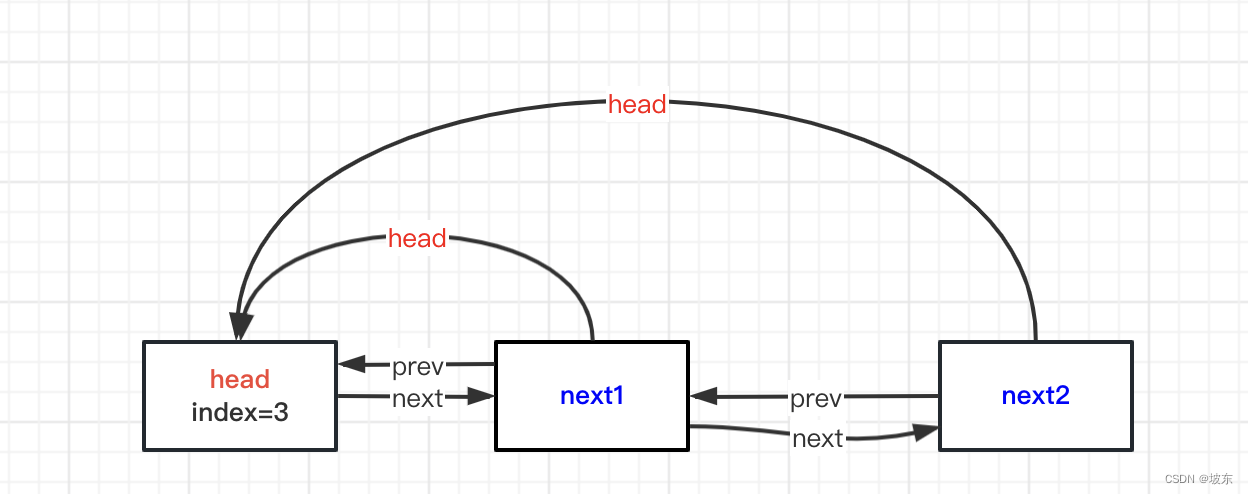
@SuppressWarnings("serial")
private static final class DefaultAttribute<T> extends AtomicReference<T> implements Attribute<T> {
private static final long serialVersionUID = -2661411462200283011L;
// The head of the linked-list this attribute belongs to
private final DefaultAttribute<?> head;
private final AttributeKey<T> key;
// Double-linked list to prev and next node to allow fast removal
private DefaultAttribute<?> prev;
private DefaultAttribute<?> next;
// Will be set to true one the attribute is removed via getAndRemove() or remove()
private volatile boolean removed;
DefaultAttribute(DefaultAttribute<?> head, AttributeKey<T> key) {
this.head = head;
this.key = key;
}
// Special constructor for the head of the linked-list.
DefaultAttribute() {
head = this;
key = null;
}
@Override
public AttributeKey<T> key() {
return key;
}
@Override
public T setIfAbsent(T value) {
while (!compareAndSet(null, value)) {
T old = get();
if (old != null) {
return old;
}
}
return null;
}
@Override
public T getAndRemove() {
removed = true;
T oldValue = getAndSet(null);
remove0();
return oldValue;
}
从DefaultAttribute的代码中得知, 每一个节点DefaultAttribute的removed属性是volatile修饰的。 接着看remove()方法的实现。
@Override
public void remove() {
removed = true;
set(null);
remove0();
}
private void remove0() {
synchronized (head) {
if (prev == null) {
// Removed before.
return;
}
prev.next = next;
if (next != null) {
next.prev = prev;
}
// Null out prev and next - this will guard against multiple remove0() calls which may corrupt
// the linked list for the bucket.
prev = null;
next = null;
}
}
}
}
remove()方法的第一步就是将removed设置为true,其他线程立即可见,如果此时正存在插入查询操作,则此时会将key插入到队列尾部。 我们来模拟key=zhangsan 的节点并发执行移除再添加的操作。
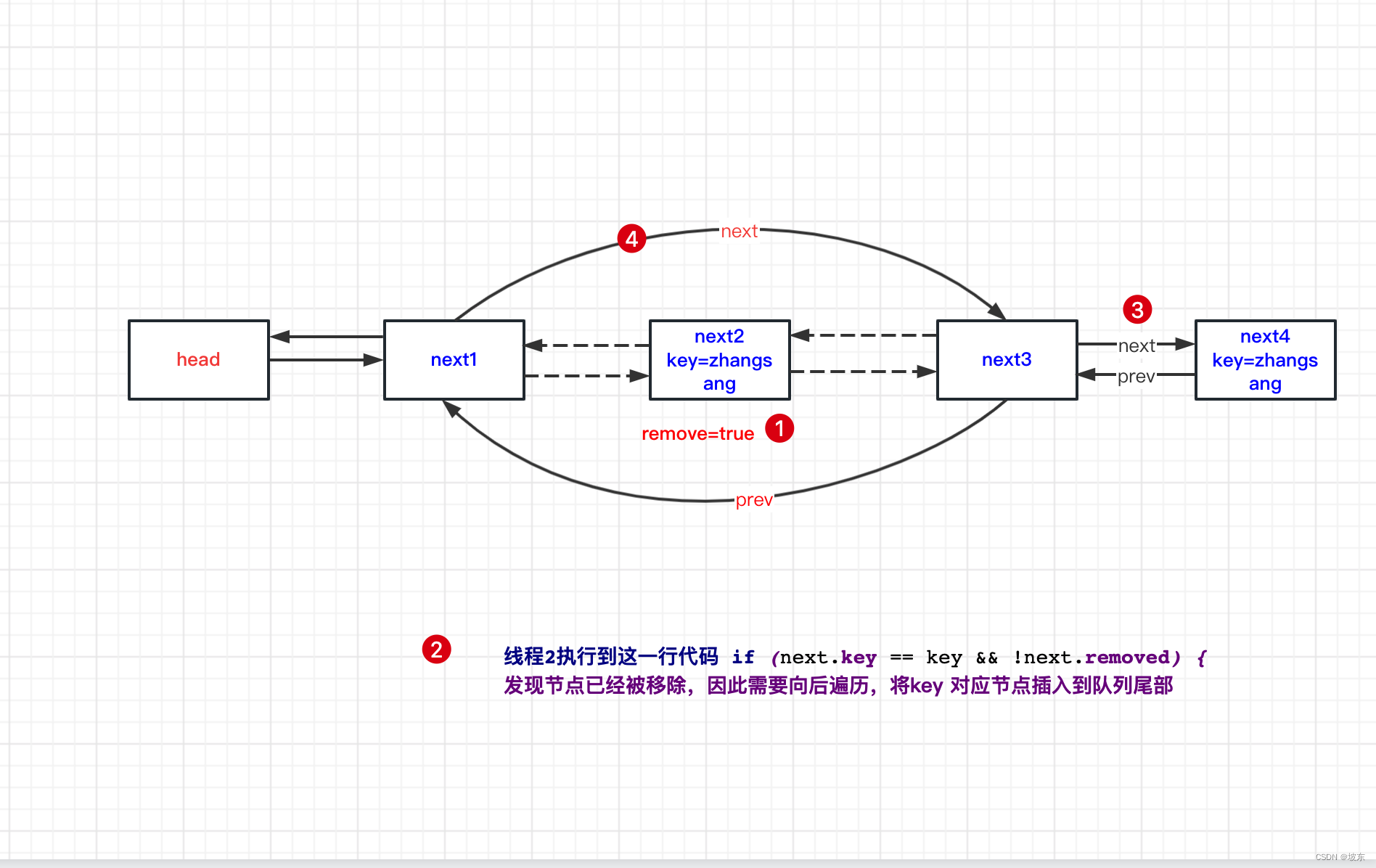
- 线程1执行下面加粗代码。
public void remove() {
removed = true;
set(null);
remove0();
}
private void remove0() {
synchronized (head) {
if (prev == null) {
return;
}
prev.next = next;
if (next != null) {
next.prev = prev;
}
prev = null;
next = null;
}
}
}
-
线程 2 抢到同步锁,并执行下面红框代码
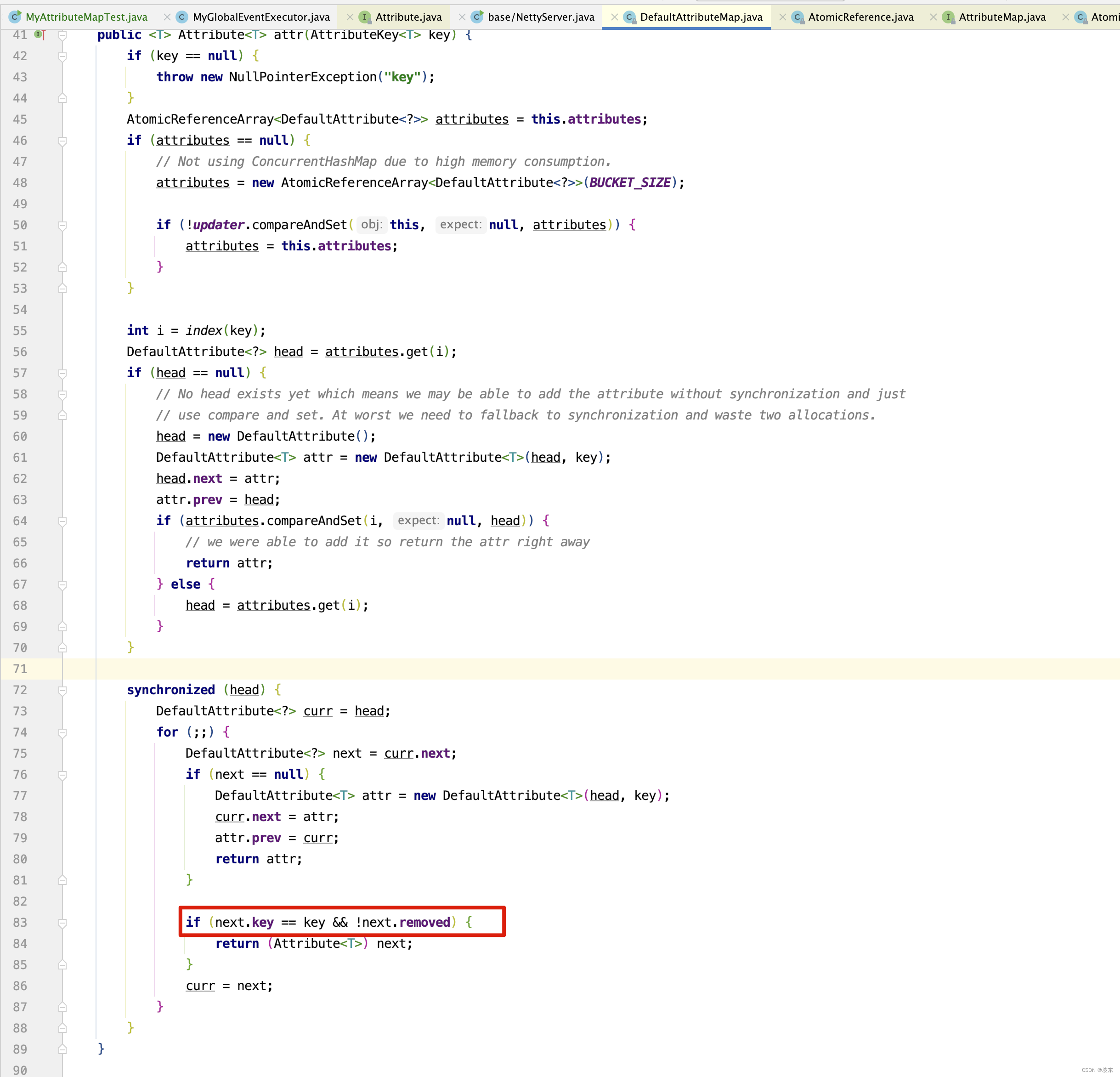
-
因为线程2 抢到锁, 因此继续执行,将key=zhangsan构建出DefaultAttribute节点,插入到队列尾部。 继续执行下面红框中的代码 。
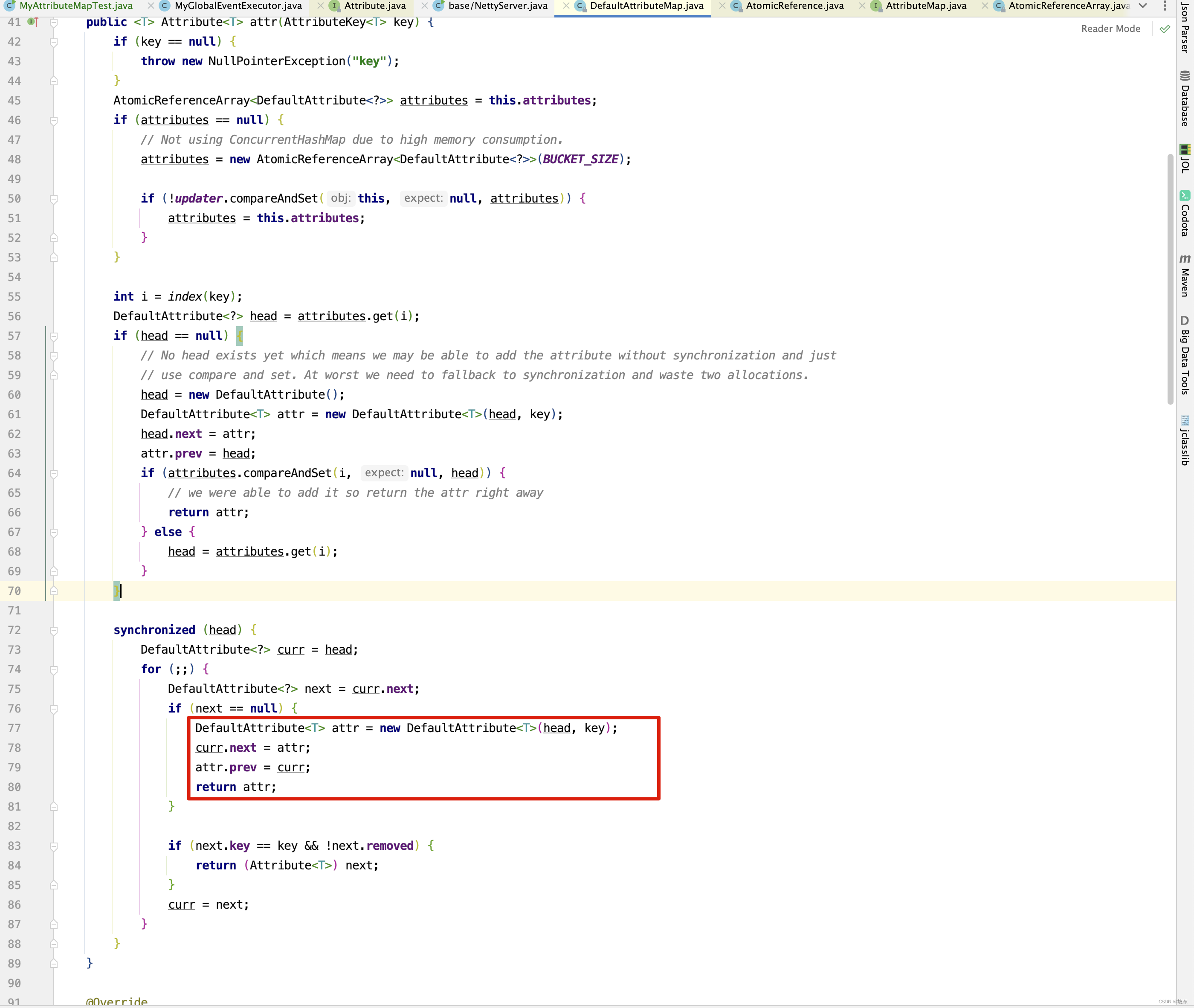
-
线程 1 等待线程 2 释放锁后,抢到同步锁。 执行后续的节点移除操作



